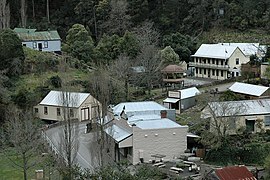Walhalla, Victoria
|
Walhalla Victoria |
|
|---|---|

View of part of Walhalla, showing mainly reconstructed buildings, including the Star Hotel/Oddfellows Hall and several original structures including the band rotunda, Corner Stores and Masonic Lodge.
|
|
| Coordinates | 37°56′37″S 146°27′03″E / 37.94361°S 146.45083°ECoordinates: 37°56′37″S 146°27′03″E / 37.94361°S 146.45083°E |
| Population | 20 |
| Postcode(s) | 3825 |
| Elevation | 360 m (1,181 ft) |
| Location | |
| LGA(s) | Shire of Baw Baw |
| State electorate(s) | Narracan |
| Federal Division(s) | McMillan |
Walhalla is a small town in Victoria, Australia, founded as a gold-mining community in early 1862 and at its peak home to around 4,000 residents. Today, the town has a population of fewer than 20 permanent residents, though it has a large proportion of houses owned as holiday properties. It attracts large numbers of tourists and is a major focus of the regional tourism industry. The town's name is taken from an early gold mine in the area, named for the German hall of fame, the Walhalla temple (Valhalla from Norse legend).
Walhalla is located in South-East Australia, in the eastern Victorian region of Gippsland, about 180 kilometres from the state capital Melbourne. It is located in the Great Dividing Range, in the steep Stringers Creek valley, approximately four kilometres upstream of the creek's junction with the Thomson River. The area around the town is designated as an historic area, adjoining the Baw Baw National Park.
The township is mainly located along one road which winds along the valley floor due to the steep terrain. After the 52 year gold rush period, Walhalla's population declined rapidly since the level of the gold has been extinct and for the latter part of the 20th century fewer than 20 people lived in the town as permanent residents.
The history of Walhalla is closely linked to the history of gold in Victoria. The first gold had been found in Victoria in 1851, leading to the Victorian gold rush. By 1859 prospectors had pushed far east of Melbourne into the trackless wilderness of the Great Dividing Range. Major gold strikes on the Jordan River encouraged other prospectors to follow the nearby Thomson River in their search for the valuable metal.
...
Wikipedia

